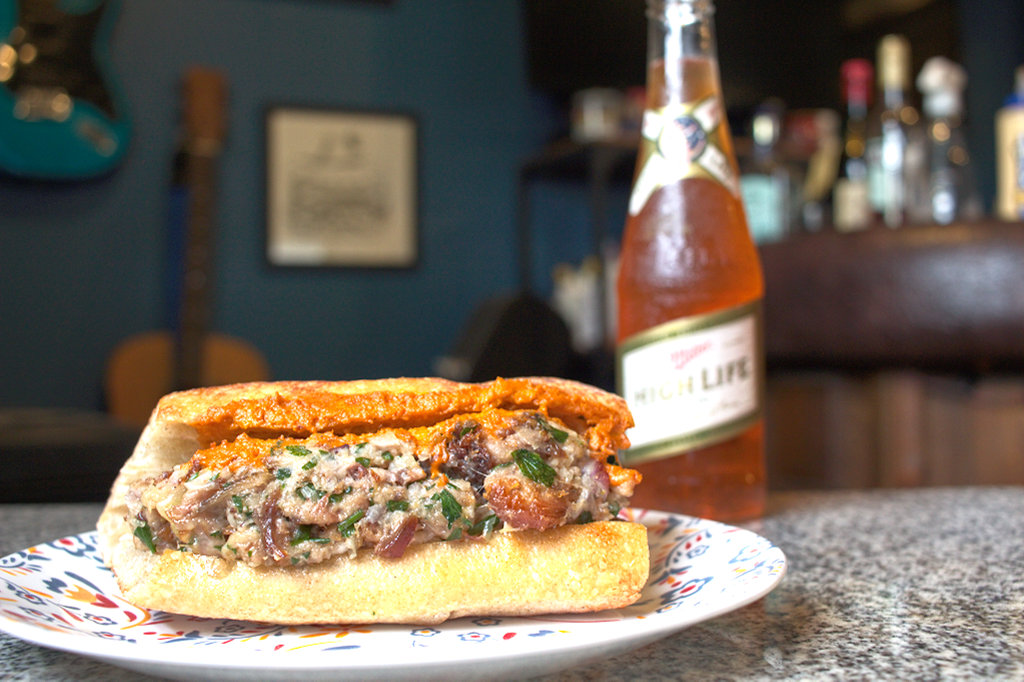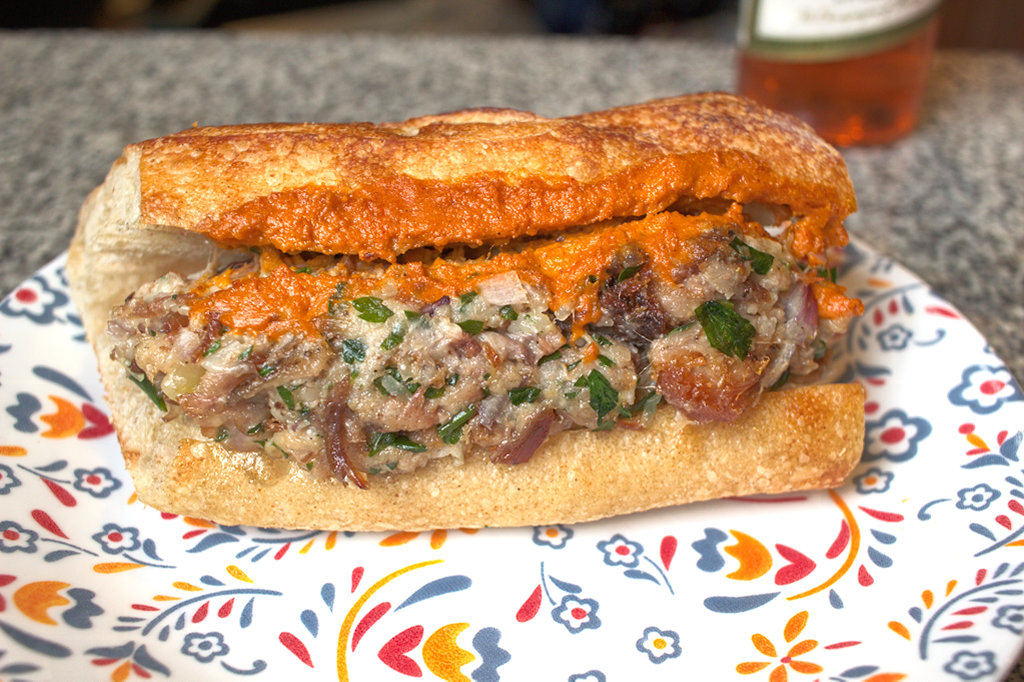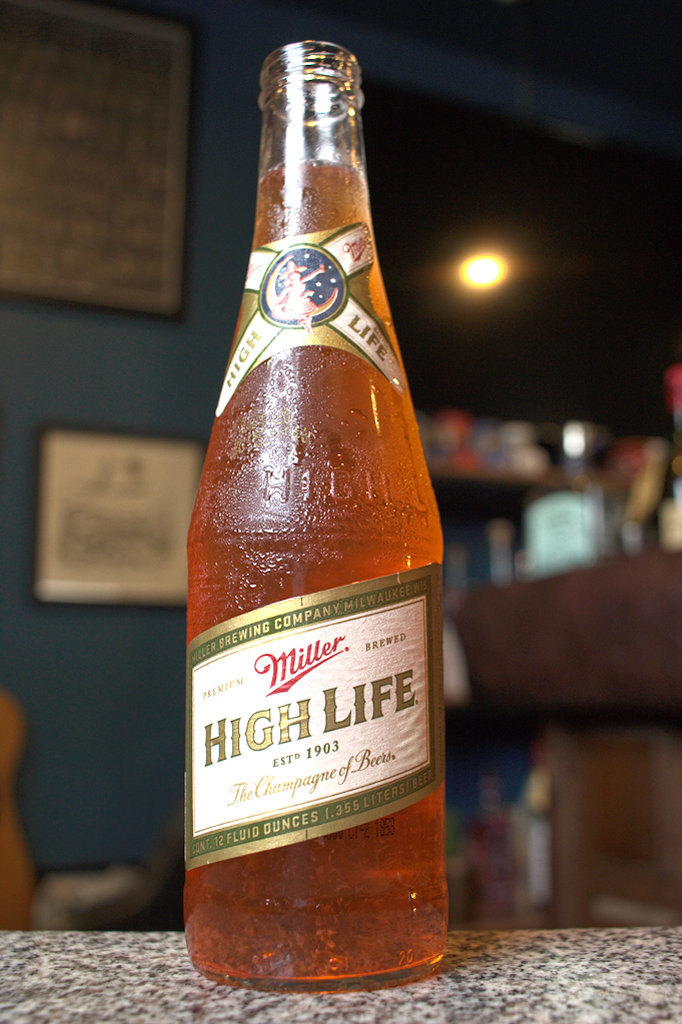Bocadillos, or bocatas, are a sandwich type in Spain. In Spain, there are several words for sandwiches–maybe not quite as many as in American English, but with somewhat explicit differences between the sandwich each word references. There’s the Montadito, a Spanish family of open-face sandwiches we explored a few years ago, and the Bocadillo, which is generally a simple combination of 1 or two ingredients enclosed in a baguette or other roll. Finally, Spanish has a word for a sandwich made with two slices of bread–they call it el sándwich.
There are a few popular named types of bocadillo, and there are nearly unlimited variants possible. At heart though, the bocadillo is not a complicated sandwich.
Bocadillos tend toward simplicity, with only a few main ingredients in each sandwich. Many feature only a single ingredient, such as Jamon Serrano, in a baguette or bread roll that’s been rubbed with garlic and tomato pulp and drizzled with olive oil.
Alternatively, the same bocadillo might use Spanish chorizo, a more salami-like sausage than the more familiar (to me, anyway) Mexican variety of chorizo.
Jamon Serrano is maybe my favorite type of ham, a powerful dry-cured ham that is covered in salt for a period of weeks, then hung to dry in special sheds in the cool mountain air for 6 to 18 months. Similar to prosciutto, it is sliced very thin and served raw with fruits or nuts or cheeses, and has a salty, funky flavor. I get nutty, cheeselike flavors and the occasional mineral tone like organ meat. The chorizo, also dry-cured, has a sharp, peppery garlic and paprika flavor. Both are complimented well by the savory and fruity combination of olive oil and tomato. It was certainly a better combination than chorizo and allioli, a powerfully garlicky Spanish (or Catalan specifically) version of aioli that is used in many types of bocadillos. Steer away from it here.
It wasn’t bad specifically, but the tomato and olive oil does a better job of allowing the chorizo flavor to come through, while the garlic of the allioli fights it for dominance.
Another classic bocadillo combination is that of membrillo, a fruit paste made from quince, with Manchego cheese.
This Manchego is a raw sheep’s milk cheese, aged for 4 months, so that it is firm and richly flavored but not terribly sharp. The quince membrillo comes as a sliceable firmly gelatinous brick of fruit preserve, not chunky but not quite smooth either, with a sweet and slightly tart flavor somewhere between a pear and a tangerine. The two are commonly paired on small plates at tapas bars, and the combination works as well when enclosed in bread.
Manchego, a versatile cheese, also works quite well in a bocadillo of Jamon Serrano with tomato and olive oil. In this case, I used a 12-month aged Manchego, firmer and sharper than the 4-month, with a more aggressive flavor comparable to that of the Serrano. The 12-month Manchego also works well with the quince membrillo, but leans much harder into the sweet/salty contrast.
If you’ve spent much time watching Anthony Bourdain shows, you’ve probably seen him make a bee-line to the nearest place serving morcilla when he does a show in Spain. Morcilla is a blood sausage, and the Spanish version is the best I’ve had. It has a deep, black color, with yellowish-white pockets of fat and a reddish film of oil on the casing’s surface. For the sandwich, I poached it gently then sliced it thick and laid it on a layer of caramelized onions, which accentuated the slightly sweet and spicy flavor of the sausage itself.
Some Spanish bocadillos are more complicated to make, while still only boasting one or two ingredients. That is because the ingredients themselves are prepared ahead of time before being combined in a bread roll for a bocadillo.
One of the better known of these is the bocadillo de tortilla española, a sandwich made with a slice of Spanish tortilla, a type of potato omelet.
The Spanish tortilla is made by slowly frying potatoes and sometimes onions in a large amount of olive oil–frying them slowly that they take on no brown color, so slowly in fact that you might even be said to be poaching the potatoes in olive oil. The potatoes and onions are then combined with egg and seasoned simply–salt and pepper, perhaps some oregano or sweet smoked paprika–and briefly fried in a non-stick pan before being finished in an oven and inverted onto a plate or serving dish.
The tortilla is then allowed to cool to room temperature before being sliced into wedges and served.
It’s a tasty and filling meal on its own or with a small salad. However, many Spanish people prefer to gild this lily by enclosing it in a section of crusty baguette and eating it that way, perhaps with some ketchup or allioli.
It’s not a bad way to eat a Spanish tortilla. While there is an aspect of the carb-on-carb type of sandwich that has never been a favorite at the Tribunal, the egg helps mitigate that issue. The tortilla is not a firm sandwich filling, and in a firmer-crumbed baguette might squish out the sides, but this baguette has a light enough crumb to conform around the tortilla and help hold it in place.
The main issue with it is that the tortilla, while tasty on its own, is not strongly-flavored enough to make up for the sheer volume of bread surrounding it. This was helped by the addition of a garlicky homemade allioli, but not quite enough. Maybe a less thickly-cut wedge of tortilla and more liberal use of condiments would help there. I may try it again some day.
Piperade is a popular Basque dish, a stew of sweet peppers, tomato, and onion, flavored with the red espelette chili. It is eaten on its own, as a side dish, or used as an ingredient in other dishes. Sometimes it is combined with scrambled eggs and eaten in a bocadillo.
Two years ago we wrote about the pepper-and-egg sandwich commonly served at Chicago sandwich shops on Fridays during Lent. This is just about as good a version of that as I can imagine existing. The tomatoes, garlic, vinegar and onion add savory, pungent, and sour flavors missing from a simple sauteed bell pepper, and the espelette pepper adds a nice layer of heat.
It was so strongly reminiscent of that sandwich, in fact, and such a good version, that I messaged my friend Mike, a connoisseur of the pepper-and-egg sandwich who had provided me with a lot of information and inspiration when I was writing about it, to let him know he needed to try this.
Escabeche is a dish of marinated fish or meat common to Iberian, Mediterranean, and Latin cuisine. Brought to Spain during the Moorish conquests of the Middle Ages, escabeche involves a brief cook of the flesh before marinating in a highly acidic mixture of citrus and/or vinegar and oil along with sauteed vegetables. A Bocadillo de Escabeche may be made with mussels or tuna or even chicken breast, but when I spotted this at a local grocery store, I knew I needed to include it in this post.
Salt cod, or bacalao in Spanish, is a highly popular ingredient in Portuguese cooking, but is also commonly used in Spain and many Latin countries. The fish is boned and preserved in a layer of salt, and requires soaking in cool water to draw the salt out of the flesh.
The escabeche recipe I settled on calls for cutting the desalted bacalao into 2 inch sections, dredging in seasoned flour, and briefly frying in olive oil. The bacalao is then placed in a nonreactive bowl and covered in a mix of sauteed peppers, onions, and garlic, olive oil, Spanish olives, white wine vinegar, and bay leaves and left to marinate overnight.
I served this the next day in a bigger, softer style of baguette that I’d heated in the oven to give a nice crisp crust. I split it only along one side to allow the bread to cup the loose ingredients, and drizzled some of the marinade into the bread crumb.
The escabeche was not well received by my family. The acid of the vinegar made the flesh of the bacalao quite firm, but the breading quite soggy. While I enjoyed the flavor of the escabeche, I prefer the texture of its South American descendant, ceviche, where the fish is placed into the marinade raw.
I do hope to discover another use for the bacalao though–I was excited to find it and would like to experiment with it again.
Whether due to a more complicated set of ingredients, or simply higher quality ones, these bocadillos are the deluxe versions that I tried this month.
The bocadillo or bocata, in Spain, is a sandwich made with Spanish bread, usually a baguette or similar type of bread, cut lengthwise. Traditionally seen as a humble food, its low cost has allowed it to evolve over time into an iconic piece of cuisine. In Spain, they are often eaten in cafes and tapas bars. Bocadillo.

Next Restaurant’s pork belly bocadillo
Next Restaurant was opened in 2011 in the Fulton Market area of Chicago’s West Side, using an inventive reservation system where tickets are purchased for certain seatings, similar to the theatre or a sporting event. Co-founded by Alinea chef Grant Achatz, it completely changed menus every few months, presenting new themes, and winning many awards along the way.
It is a far fancier restaurant than I would generally eat at, especially for the Tribunal. However, since Shelter in Place order issued in Illinois as a result of the COVID-19 pandemic, they switched to a take-home meal kit model, with meals that were more reasonably-priced than I suspected a restaurant like this would offer. Earlier this month they announced a Spanish menu, with paella, a Manchego cheese spread, a crema-based dessert, and an optional bocadillo with Jamon Iberico.
I needed that bocadillo.
Sadly by the time I was able to sign up, they had run out of the Jamon Iberico, but were instead offering pork belly bocadillos as a optional addition to the menu. Mindy and I decided to give it a shot. The paella was tasty enough, though the shrimp it came with was possibly the best-cooked piece of shrimp I’d ever eaten. The manchego spread had a kick, tasting like a fancier pimento cheese and the crema, while delicious, was gone in an instant. The bocadillo though was what I had signed on for.
 Pork belly bocadillo from Next Restaurant with Spaghett beverage
Pork belly bocadillo from Next Restaurant with Spaghett beverage Pork belly bocadillo from Next Restaurant
Pork belly bocadillo from Next Restaurant Spaghett
Spaghett
The pork belly was good, brightly-flavored, minced with cilantro and onion and some kind of citrus, dressed with a peppery orange sauce, and served in a crusty chewy section of baguette. It was more than enough sandwich for an entire meal, and along with the paella and cheese and crema, I was unable to finish it, though it made an even better breakfast as leftovers. We skipped the Next beverage pairings and decided to make the Baltimorean Spaghett cocktail that had its time in the sun last summer, a mixture of Miller High Life with Aperol and lemon juice that I served in High Life bottles.
Overall, the Next experience made for a good special occasion meal and we may try it again soon. They’ve already moved on from the Spanish menu and currently list Japanese and Italian meals on their web site. I’ll be keeping an eye on them to see what happens next.
TasteAtlas food rankings are based on the ratings of the TasteAtlas audience, with a series of mechanisms that recognize real users and that ignore bot, nationalist or local patriotic ratings, and give additional value to the ratings of users that the system recognizes as knowledgeable. For the “Top 28 Spanish Sandwiches” list until March 15, 2024, 1,255 ratings were recorded, of which 1,054 were recognized by the system as legitimate. TasteAtlas Rankings should not be seen as the final global conclusion about food. Their purpose is to promote excellent local foods, instill pride in traditional dishes, and arouse curiosity about dishes you haven’t tried.
Spain’s Most Delicious Sandwich | Serranito Recipe
FAQ
What is the most popular Spanish sandwich?
What is a Spanish chicken sandwich called?
What are the little sandwiches in Spain?
What is a mixed sandwich in Spain?
Is a sandwich considered a snack in Spain?
A sandwich is definitely not considered much more than a snack in Spain. The second type of sandwich is the traditional bocadillo, made with a rustic barra de pan or baguette-style bread loaf. Bocadillos are served everywhere from taverns and bars to cafeterias, roadside establishments, and at home.
What is the most stacked Sandwich in Spain?
The serranito may just be the most stacked sandwich in all of Spain. It essentially consists of the five most beloved ingredients in the Spanish diet, all stuffed between bread to make one stellar sandwich.
How do you make a good ham sandwich in Spain?
As with most of the best Spanish dishes, this one couldn’t be easier to make. Butter both sides of your bread, add plenty of thinly-sliced pieces of your favorite cheese and good quality ham (what we call jamón york here in Spain—not cured ham!) and grill! Spanish snack perfection in minutes.
What is a serranito sandwich?
From the sun-kissed landscapes of Andalusia in southern Spain comes a sandwich that’s a true feast for the senses: the Serranito. This isn’t just a quick bite; it’s a culinary journey that captures the essence of Andalusian flavors and traditions. At the heart of the Serranito is its rich filling.
